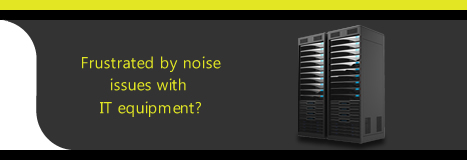Thermal Guidelines
This page provides some general good-practice rack planning guidelines that will help optimize cooling efficiency inside a Quiet-Rack cabinet. This said, the thermal capacity of a particular rack will be influenced by several unique factors, such as equipment arrangement, capacity and immediate environment; therefore, monitoring operating conditions for installed equipment remains the responsibility of the system administrator.
i) Make a Population Plan
Before physically populating your quiet rack it is important to plan how the equipment will be arranged within the rack. We propose the following guidance:
- Get acquainted with your Equipment
Firstly, understand the thermal design of each piece of apparatus. How is it vented – front to rear, or side to side? This is important because most quiet-racks depend upon front to rear venting for maximum cooling efficiency. Having said this, adapters are available that will facilitate side to side venting – your local Quiet-Rack accredited reseller partner will be able to advise you about this.
- Evenly Distribute the Hottest Devices
Distribute the thermal load evenly throughout the rack and avoid bunching the hotter running items together, such as servers and dense RAID arrays. If at all possible, leave at least a 1U gap between these devices; this serves to minimise the build up of heat caused by convection.
Sometimes, it may be necessary to mount equipment in both the front and rear of the cabinet. If this is the case, only those items that are not cooled using assisted airflow and with low thermal output should be placed at the rear.
ii) Use of Blanking Panels
Filling all gaps between the equipment at the front of the rack with soundproofed blanking plates has the following benefits to cooling efficiency and noise reduction:
- It reduces the possibility of warm air being re-circulated within the cabinet
- Cool air is channelled to where it is needed
- Being soundproofed, the blanking plates will enhance the overall acoustic performance of the cabinet
The airflow design and form factor of certain equipment can prevent the use of standard blanking plates. In these situations the following accessories are available:
- Tower Infill Kit – designed to blank-off the area around tower servers and PC's
- Side to side venting kit – enables the installation of side to side vented equipment without a loss in cooling performance
iii) Air Conditioning/Room Temperatures
Ideally, the room air temperature should not exceed 77°F / 25°C if at all possible.
As all quiet racks are air-cooled the temperature maintained within the cabinet is directly related to the air-intake temperature and is therefore reliant upon the efficiency of the room's climate control system.
iv) Choice of Location
When choosing a suitable location for a quiet rack the following should be considered:
- Do not block or inhibit free air-flow into and out of the cabinet.
- Avoid positioning a quiet-enclosure near to a heat source (such as a central heating system).
- Do place the cabinet underneath or near to a ceiling air conditioning unit when possible. This will significantly enhance the internal operating temperature of the rack.
In some cases it may be desirable to remove warm air from the cabinet directly to the outside or into a building ventilation system. If this is the case we recommend that you speak with your local Quiet-Rack accredited reseller partner who will be able to advise you on available options.
v) Dust Prevention
Dust will act as a thermal insulator when allowed to build up around key components as well as impede air-flow by blocking air vents critical to cooling efficiency. Therefore the build up of dust is to be avoided.
By placing air-filters over air-intake vents most quiet rack manufacturers now offer protection against dust ingress. In some cases this is a standard feature of the quiet enclosure however in most cases this remains an optional accessory.











